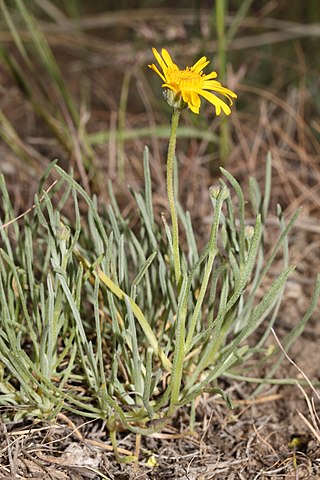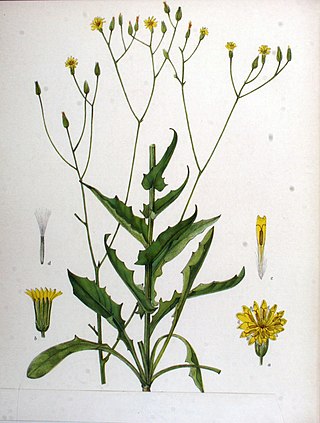Crepis monticola is a North American species of flowering plant in the family Asteraceae known by the common name mountain hawksbeard.

Erigeron linearis is a species of flowering plant in the family Asteraceae known by the common name desert yellow fleabane or narrow leaved fleabane. It is native to western North America.

Helianthella californica is a species of flowering plant in the family Asteraceae known by the common name California helianthella. This wildflower is native to the mountains of California, northwestern Nevada, and southwestern Oregon.

Antennaria flagellaris is a North American species of flowering plant in the family Asteraceae known by the common names whip pussytoes and stoloniferous pussytoes. It is native primarily to the Great Basin and Columbia Plateau regions of Washington, Oregon, Idaho, and northern Nevada, where it is a member of the sagebrush scrub plant community. Additional populations are found in northeastern California, Wyoming, the Black Hills of South Dakota, and the Canadian Province of British Columbia.

Antennaria luzuloides is a North American species of flowering plant in the family Asteraceae known by the common name rush pussytoes. The species is native to western Canada and the western United States.

Arnica sororia is a North American species of flowering plant known by the common name twin arnica. It is native to Western Canada and the Western United States. It grows in grasslands and in conifer forests, as well as the sagebrush steppe.

Artemisia arbuscula is a North American species of sagebrush known by the common names little sagebrush, low sagebrush, or black sagebrush. It is native to the western United States from Washington, Oregon, and California east as far as Colorado and Wyoming. It grows in open, exposed habitat on dry, sterile soils high in rock and clay content.

Chrysothamnus viscidiflorus is a species of shrub in the family Asteraceae of the Americas known by the common names yellow rabbitbrush and green rabbitbrush.

Crepis acuminata is a North American species of flowering plant in the family Asteraceae known by the common name tapertip hawksbeard. It is native to the western United States where it grows in many types of open habitat.
Crepis bakeri is a species of flowering plant in the family Asteraceae known by the common name Baker's hawksbeard. It is native to the western United States where it grows in many types of mountain and plateau habitat. It is found in Oregon, Washington, Idaho, northern California, Nevada, and Utah.

Crepis intermedia is a North American species of flowering plant in the family Asteraceae known by the common name limestone hawksbeard. It is native to the Pacific Northwest, Columbia Plateau, Great Plains and Southwestern regions of western North America.

Crepis occidentalis is a North American species of flowering plant in the family Asteraceae known by the common names western hawksbeard, or largeflower hawksbeard. It is native to western Canada and the western United States.
Crepis pleurocarpa is a North American species of flowering plant in the family Asteraceae known by the common name nakedstem hawksbeard. It is native to the western United States (Washington, Oregon, northern California and western Nevada.

Crepis runcinata is a North American species of flowering plant in the family Asteraceae known by the common name fiddleleaf hawksbeard. It is native to western and central Canada, the western and central United States and northern Mexico (Chihuahua).

Orobanche californica, known by the common name California broomrape, is a species of broomrape. It is a parasitic plant growing attached to the roots of other plants, usually members of the Asteraceae.

Arnica lanceolata is a North American species of flowering plant in the family Asteraceae, known by the common name clasping arnica or lanceleaf arnica. It has a disjunct (discontinuous) distribution in western North America and northeastern North America.

Askellia pygmaea, the dwarf alpine hawksbeard, is a species of Asian and North American plants in the tribe Cichorieae within the family Asteraceae.
Crepis atribarba is a North American species of flowering plant in the family Asteraceae known by the common names slender hawksbeard and dark hawksbeard. It is native to western Canada and the western United States It has been found in British Columbia, Utah, Washington, Oregon, Nevada, Idaho, Alberta, Montana, Wyoming, Colorado, Saskatchewan, and Nebraska.

Crepis pulchra is a European species of flowering plant in the family Asteraceae with the common name smallflower hawksbeard. It is widespread across much of Europe as well as in Morocco, Algeria, and western and central Asia. It has also become naturalized in the parts of the United States and in the Canadian Province of Ontario.

Crepis vesicaria is a European species of flowering plant in the family Asteraceae with the common name beaked hawk's-beard. It is native to the Western and Southern Europe from Ireland and Portugal east as far as Germany, Austria, and Greece. It became naturalized in scattered locations in North America.


















